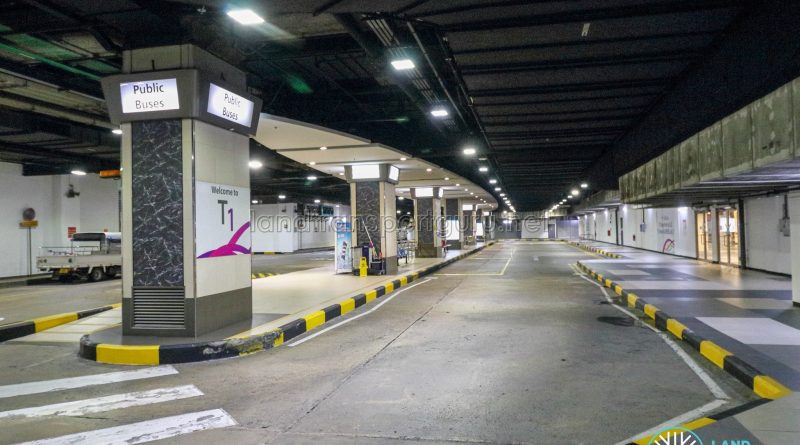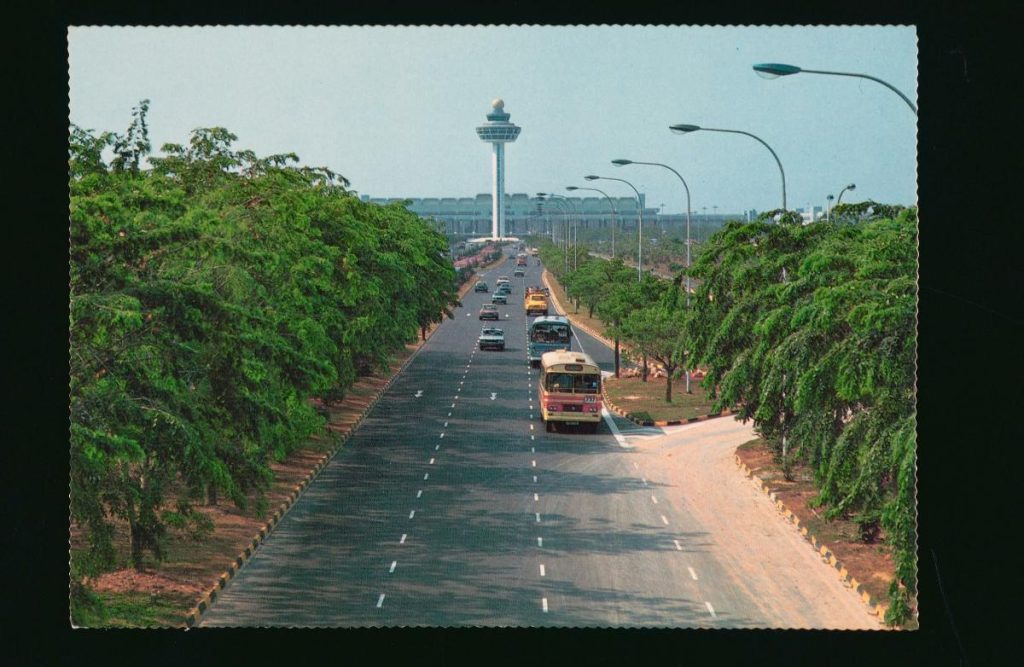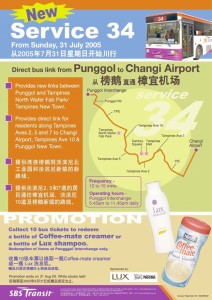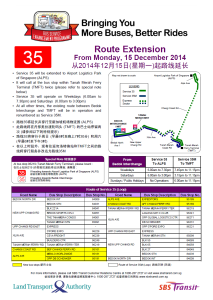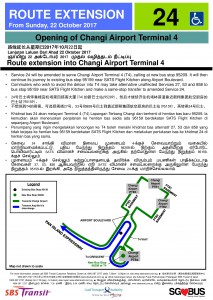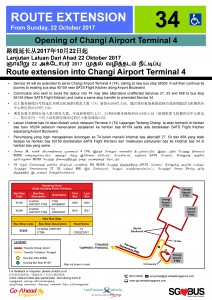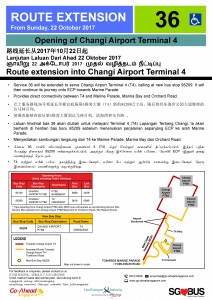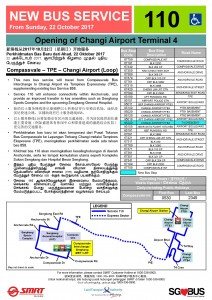Over the past four decades, public bus services serving the Changi International Airport of Singapore have evolved significantly, ranging from 2 major bus plans by the Singapore Bus Service (SBS) in the 1980s, to the introduction of more direct bus services between major residential estates and the new airport between the 1990s and 2010s.
Changi Airport Bus Plan 1981 (22 Feb 1981 – 24 Jun 1983)
Prior to the official opening of Changi Airport on 1 July 1981, SBS proposed a series of special bus services that connected nearby residential towns, as well as the Central Business District (CBD), with the new airport.
Known as the Changi Airport Bus Plan of 1981, six bus services numbered in the 39x series were progressively introduced in early 1981, connecting the bus interchanges in Bedok and Somapah, as well as Changi Point Bus Terminal, with the Passenger Terminal Building (PTB) and the Changi Airport Cargo Complex (CACC).
Specifically, Somapah Bus Interchange was designated by SBS as an interchange for airport bus services due to its proximity to the upcoming Changi Airport and the availability of multiple trunk bus services to other parts of Singapore, including Bus Services 10 (Jurong), 11 (New Bridge Rd), 12 (Buona Vista), 14 (Bukit Merah) and 155 (Toa Payoh).
Bus Service 391 was the first Changi Airport Service (CAS) to be launched on Sunday, 22 February 1981, operating between Changi Point and Nicoll Dr (outside the upcoming CACC), as the road leading to CACC was still under construction at the time. It replaced Feeder Bus Service 213, which was discontinued on the same day.
Bus Service 394 was launched as the second CAS between Bedok and Changi Airport PTB on 3 May, followed by Bus Services 392 and 393 from Somapah to Changi Airport PTB and CACC respectively on 7 June. The final 2 CAS, Bus Services 390 and 395, were launched 2 weeks later on 21 June between Changi Airport PTB and Queen Street Bus Terminal, as well as between Bedok and CACC respectively.
Due to extremely low demand, Bus Service 394 was briefly converted to a peak hour service shortly after its introduction, before its reinstatement as a full day service days before the official opening of Changi Airport.
To complement the six SBS bus services, the Singapore Shuttle Bus (SSB), which was operating City Shuttle Services (CSS) at the time, worked with Scheme B bus operators – Singapore School and Private Hire Bus Owners’ Association (SBOA) and Singapore School Transport Association (SSTA) – to operate four additional peak hour bus services connecting the residential towns of Ang Mo Kio (727), Toa Payoh (737), Kallang Basin (747) and Queenstown (757) with the new airport. An additional Airport Shuttle Service (767) was also operated by SSB between Changi Airport PTB and CACC, providing greater convenience for airport workers and other commuters travelling between both parts of the airport. A total of 90 buses from SSB and the Scheme B operators were deployed on the five additional services.
In November 1981, CAS Bus Service 393 was integrated with CAS Bus Service 395, forming an integrated Bus Service 393 between Bedok, Somapah and CACC.
Controversy surrounding Changi Airport Bus Plan 1981
Despite having multiple bus services serving the new Changi Airport from the first bus plan, there were teething issues with the operations of these bus services. Specifically, the supplementary airport bus services under SSB, SBOA and SSTA suffered from low ridership, which led to their appeal to the Registry of Vehicles (ROV) to reduce their frequencies, only about a month after their debut.
Subsequently, it was revealed in a Straits Times article published in March 1982 that the ROV had agreed to SSB’s appeal to reduce the number of buses deployed on the supplementary airport bus services due to low ridership. In addition, the article also mentioned that the airport bus services under SBS also suffered from low demand, with only 30 to 40% of the capacity being taken up by commuters on these services.
In April 1983, a further complaint was raised by a Pasir Panjang resident regarding the reliability for the SSB airport services to then-Minister for Communications, Mr Ong Teng Cheong. Responding to the complaint, the Minister had said that SSB will be stripped of the operating rights to these services if they did not improve their service levels.
SSB later responded to the Minister’s comments, insisting that they maintained the original service levels for their airport bus services, despite losing about $400,000 a year due to the unprofitability of these bus services. Instead, they placed the blame on the Scheme B bus operators for the reduction in service levels on the five airport bus services which were jointly run with SSB, claiming that the Scheme B bus operators “cut corners by reducing the frequency of buses when they found the bus services to be unprofitable”. At the time, SSB and Scheme B buses operated alternately on Bus Services 727, 737, 747 and 757, which led to service degradation when the Scheme B bus operators reduced the number of buses deployed on the bus services on their own accord, leading to regular commuters on these bus services being forced to wait for the next SSB bus.
In addition, SSB revealed that they had made several suggestions in July 1982, including:
- Fully taking over the operations of Bus Services 727, 737, 747 and 757 from the Scheme B bus operators, allowing for the full implementation of fixed time schedules.
- Setting up an additional bus interchange for its airport bus services, allowing the supplementary airport bus services to terminate at the bus interchange to improve their reliability. An additional bus service was also proposed to operate between the additional bus interchange and the airport.
- Implementing a through-ticketing system to ensure that commuters do not have to pay more when transferring between bus services at the proposed bus interchanges.
Changi Airport Bus Plan 1983 (25 Jun 1983 – Present)
Following the controversies of the supplementary airport bus services jointly operated by SSB and various Scheme B bus operators, SBS proposed a second bus plan for Changi Airport in May 1983, absorbing their existing airport bus services, as well as the other airport bus services under SSB.
The following changes were implemented under the new bus plan from Saturday, 25 June 1983:
- CAS Service 390: Route extended to loop at Orchard Road from its present terminus at Queen Street, starting operations from Changi Airport PTB
- CAS Service 391: Route integrated with Bus Service 9, which was extended from Changi Village to CACC
- CAS Service 392: Route integrated into new Bus Service 24, operating between Ang Mo Kio, Bedok, Somapah and Changi Airport PTB
- CAS Service 394: Route integrated into new Bus Service 24, operating between Ang Mo Kio, Bedok, Somapah and Changi Airport PTB
- CAS Service 395: Route integrated with Bus Service 9, which was extended from Changi Village to CACC
- SSB Service 727: Route integrated into new Bus Service 24, operating between Ang Mo Kio, Bedok, Somapah and Changi Airport PTB
- SSB Service 737: Route integrated into new Bus Service 149, operating between Toa Payoh, Kallang Basin, Marine Parade and Changi Airport PTB
- SSB Service 747: Route integrated into new Bus Service 149, operating between Toa Payoh, Kallang Basin, Marine Parade and Changi Airport PTB
- SSB Service 757: Route converted to new peak hour Bus Service 57, operating between Queenstown and Changi Airport PTB
Subsequent Bus Service Changes
Summary of Subsequent Bus Service Changes (Refer to subsequent paragraphs for more details):
- 1985 (9 Jun): Bus Service 29 introduced between Tampines and Changi Airport Cargo Complex via Upp Changi Rd Nth
- 1986 (16 Feb): Bus Service 390 extended to Holland Fringe Car Park
- 1987 (19 Apr): Bus Service 57 (Buona Vista – Changi Airport PTB) discontinued
- 1988 (24 Jan): Bus Service 27 introduced between Tampines and Changi Airport PTB
- 1989 (11 Jun): Bus Service 390 reverted to loop at Orchard Rd
- 1990 (13 Oct): Opening of Changi Airport PTB 2
- 1992 (29 Nov): Bus Service 9 shortened to Bedok; Bus Service 27 extended to Pasir Ris; Bus Service 29 shortened to end at Changi Village after 19:30 daily
- 1993 (5 Dec): Bus Service 16 extended to Changi Airport; Bus Services 149 & 390 discontinued
- 1994 (23 Jan): Bus Service 19 introduced between Tampines and Changi Airport Cargo Complex via Loyang Ave; Bus Service 29 shortened to Changi Village permanently
- 1994 (31 Jan): Bus Service 16E introduced between Bukit Merah and Changi Airport, skipping Old Airport Rd, Joo Chiat & Marine Parade
- 1995 (23 Apr): Bus Service 27 reverted to Tampines; Bus Service 34 introduced between Bedok and Changi Airport; Bus Service 53 extended to Changi Airport via Pasir Ris
- 1997 (2 Nov): Bus Service 858 extended to Changi Airport
- 1997 (1 Dec): Bus Service 16E re-numbered as Bus Service 36
- 1998 (6 Sep): Bus Service 36 amended to start from Changi Airport and shortened to loop at Orchard Rd via Marine Parade and Marina Centre
- 1999 (5 Dec): Bus Service 89 introduced between Hougang, Sengkang, Pasir Ris and Changi Airport Cargo Complex
- 2000 (3 Sep): Express Bus Service 506 extended to Changi Airport
- 2000 (24 Nov): Nite Owl Bus Service 36M introduced, plying the same route as Bus Service 36 during midnight on Fridays, Saturdays & eves of PHs
- 2001 (9 Mar): NightRider Bus Service NR13 introduced between Lor 1 Geylang and Changi Airport
- 2001 (5 Aug): Bus Service 989 introduced between Choa Chu Kang, Bukit Batok and Changi Airport
- 2001 (1 Dec): NightRider Bus Service NR13 discontinued
- 2001 (7 Dec): Nite Owl Bus Service 36M discontinued
- 2002 (15 Sep): Bus Service 34 discontinued; Express Bus Service 506 reverted to Bedok
- 2003 (27 Jul): Bus Service 989 discontinued
- 2005 (31 Jul): Bus Service 34 re-introduced between Punggol, Tampines and Changi Airport
- 2005 (19 Sep): Fast Forward Bus Service 89e introduced between Hougang, Sengkang, Pasir Ris and Changi Airfreight Centre, skipping Pasir Ris completely
- 2007 (11 Nov): Opening of Changi Airport PTB 3
- 2014 (15 Dec): Bus Service 35 extended to Airport Logistics Park of Singapore (ALPS), providing a new alternative route for existing commuters of Bus Services 9, 19, 89 & 89e
- 2017 (22 Oct): Opening of Changi Airport PTB 4 (with Bus Services 24, 34 & 36 amended only); Bus Service 110 introduced between Sengkang and Changi Airport
Due to persistently low ridership, peak hour Bus Service 57 between Buona Vista and Changi Airport PTB was eventually discontinued by SBS in 1987.
With the completion of Tampines New Town in the late 1980s, SBS launched 2 bus services to connect the new town with the CACC and Changi Airport PTB – Bus Service 29 in 1985 and Bus Service 27 in 1988.
In 1990, Terminal 2 of Changi Airport opened for passenger service. All existing bus services (24, 27, 149 & 390) were amended to serve the new PTB in Changi Airport T2, on top of the existing PTB in Changi Airport T1.
Under the Transitlink Integration Exercise, Bus Service 9 was shortened to Bedok from Geylang in 1992 to reduce its duplication with the East West Line (EWL). At the same time, Bus Service 27 had its route extended to Pasir Ris, providing greater accessibility between the new estate and the airport.
Under the final phase of the exercise, Bus Service 149, which operated between Toa Payoh and Changi Airport, was integrated with existing Bus Services 16 and 31. As a result, the former was extended from Marine Parade to Changi Airport, while the latter was extended from Kallang Park to Toa Payoh. At the same time, Bus Service 390 was also discontinued, officially marking the end of the first-generation airport bus services under SBS.
The discontinuation of Bus Service 390 led to some discontent among former commuters of the service, who appealed to SBS to reinstate the bus service. In response, SBS introduced a new semi-express Bus Service 16E the following month, which utilised express sectors along the East Coast Parkway (ECP) and skipped Marine Parade, Joo Chiat and Dakota completely. Bus Service 16E was eventually re-numbered as trunk Bus Service 36 in 1997, and extended its route into Marine Parade and Marina Centre in 1998.
Similar discontent was also expressed by commuters of Bus Service 29, which took a long detour via Upp Changi Rd North and Changi Village before entering the CACC. This was because when Bus Service 29 was first introduced in 1985, Loyang Ave was still under construction, which meant that the bus service could only use Upp Changi Rd to get to CACC. To provide a faster journey for commuters, Bus Service 19 was introduced by SBS in 1994, using the more direct Loyang Ave to travel between Tampines and CACC and permanently replacing Bus Service 29, which was shortened to Changi Village at the same time.
With the opening of the Tampines Expressway (TPE) and the extension of the Pan-Island Expressway (PIE) in the late 1990s, more bus services were introduced to serve Changi Airport and Changi Airfreight Centre:
- Bus Service 53 was extended to Changi Airport from Hougang South via Pasir Ris on Sunday, 23 April 1995, permanently displacing the role of Bus Service 27 in Pasir Ris. On the same day, Bus Service 34 was introduced as a day service between Bedok and Changi Airport, but took a different route from the defunct Bus Service 394.
- Bus Service 858 was extended to Changi Airport from Yishun on Sunday, 2 November 1997, becoming the first bus service by Trans-Island Bus Service (TIBS) to serve Changi Airport.
- Bus Service 27 was extended from Tampines to Sengkang on Sunday, 25 July 1999. It was later further extended to Hougang on Sunday, 29 December 2002.
- Bus Service 89 was introduced as a new service between Hougang, Sengkang, Pasir Ris and Changi AirFreight Centre from Sunday, 5 December 1999.
- Express Bus Service 506 was extended to Changi Airport from Bedok on Sunday, 3 September 2000, becoming the first and only Express bus service to serve Changi Airport.
- Bus Service 989 was introduced as a new service between Choa Chu Kang, Bukit Batok, Toa Payoh, Kallang Basin and Changi Airport from Sunday, 5 August 2001.
2 night buses also briefly operated in Changi Airport between 2000 and 2001 – Nite Owl Bus Service 36M to Orchard Road and NightRider Bus Service NR13 to Lorong 1 Geylang Bus Terminal.
With the opening of Changi Airport MRT station along the Changi Airport Extension of the EWL in 2002, Bus Services 34 and 506 were discontinued and reinstated back to Bedok respectively to reduce route duplication with the new MRT line. Bus Service 989 was also shortened to Lorong 1 Geylang Bus Terminal and re-numbered as Bus Service 985 in 2003.
To improve accessibility to the developing Punggol New Town and complement existing demand in Tampines New Town, SBS Transit introduced a new Bus Service 34 from Sunday, 31 July 2005.
To provide faster journeys between Hougang, Sengkang and the Changi Airfreight Centre, SBS Transit introduced a new Fast Forward Bus Service 89e on Monday, 19 September 2005.
In 2007, Terminal 3 of Changi Airport opened for passenger service. All existing bus services (24, 27, 34, 36, 53 & 858) were amended to serve the new PTB in Changi Airport T3.
In 2014, Bus Service 35 was extended from Tanah Merah Ferry Terminal to serve the Airport Logistics Park of Singapore (ALPS) on weekdays and Saturdays, providing greater accessibility for more airport workers.
In 2017, Terminal 4 of Changi Airport opened for passenger service. Three existing bus services (24, 34 & 36) were amended to serve the new PTB in Changi Airport T4. At the same time, a new Bus Service 110 was also introduced, connecting all 4 PTBs in Changi Airport directly with Sengkang New Town.
Poster Gallery:
1981 Routes
| Service | Route / Date Launched | Route |
| 390 | Queen St – Changi Airport PTB (28 June 1981) |
Direction 1 Queen St, Ophir Rd, Blanco Court, (ECP), Airport Blvd and Changi Airport PTB. Direction 2 Airport Blvd, (ECP), Rochor Rd, Victoria St, Arab St and Queen St. |
| 391 | Changi Point – Changi Cargo Cplx (Loop) (22 February 1981) |
Upp Changi Rd, Telok Paku Rd, Nicoll Dr, Coastal Rd, Changi Cargo Cplx (loop), Coastal Rd, Nicoll Dr, Telok Paku Rd and Upp Changi Rd. |
| 392 | Somapah – Changi Airport PTB (28 June 1981) |
Direction 1 Upp Changi Rd East, (PIE, ECP), Airport Blvd and Changi Airport PTB. Direction 2 Airport Blvd, (ECP, PIE) and Upp Changi Rd East. |
| 393 | Somapah – Changi Cargo Cplx (Loop) (28 June 1981) |
Upp Changi Rd East, Loyang Ave, Telok Paku Rd, Nicoll Dr, Coastal Rd, Changi Cargo Cplx (loop), Coastal Rd, Nicoll Dr, Telok Paku Rd, Loyang Ave and Upp Changi Rd East. |
| 394 | Bedok – Changi Airport PTB (3 May 1981) |
Direction 1 Bedok North Ave 1, Bedok South Rd, Bedok South Ave 1, (ECP), Airport Blvd and Changi Airport PTB. Direction 2 Airport Blvd, (ECP), Bedok South Ave 1, Bedok South Rd and New Upp Changi Rd. |
| 395 | Bedok – Changi Cargo Cplx (Loop) (28 June 1981) |
Bedok North Ave 1, Bedok South Rd, Bedok South Ave 1, (ECP), Coastal Rd, Changi Cargo Cplx (loop), Coastal Rd, (ECP), Bedok South Ave 1, Bedok South Rd and New Upp Changi Rd. |
| 727 | Ang Mo Kio – Changi Airport PTB (28 June 1981) |
Direction 1 Ang Mo Kio Ave 8 (Blk 510), Ang Mo Kio Ave 3, Ang Mo Kio Ave 6, Ang Mo Kio Ave 1, Lor Chuan, Boundary Rd, Upp Paya Lebar Rd, Airport Rd, Airport Link, Jln Eunos, Sims Ave East, New Upp Changi Rd, Bedok South Rd, Bedok South Ave 1, (ECP), Airport Blvd and Changi Airport PTB. Direction 2 Airport Blvd, (ECP), Bedok South Ave 1, Bedok South Rd, New Upp Changi Rd, Changi Rd, Jln Eunos, Airport Link, Airport Rd, Upp Paya Lebar Rd, Boundary Rd, Lor Chuan, Ang Mo Kio Ave 1, Ang Mo Kio Ave 6, Ang Mo Kio Ave 3, Ang Mo Kio Ave 8, Ang Mo Kio St 53, Ang Mo Kio Ave 5 and Ang Mo Kio Ave 8. |
| 737 | Toa Payoh – Changi Airport PTB (28 June 1981) |
Direction 1 Lor 1 Toa Payoh (Blk 154), Lor 6 Toa Payoh, (Slip Rd), Jln Toa Payoh, MacPherson Rd, Aljunied Rd, Merpati Rd, Circuit Rd, Paya Lebar Way, (PIE, ECP), Airport Blvd and Changi Airport PTB. Direction 2 Airport Blvd, (ECP, PIE), Paya Lebar Way, Paya Lebar Rd, Lor Bengkok, Circuit Rd, Pipit Rd, Circuit Rd, Merpati Rd, Mattar Rd, Aljunied Rd, MacPherson Rd, Bendemeer Rd, Whampoa North, Serangoon Rd, Jln Toa Payoh, (Flyover, Access Rd), Lor 2 Toa Payoh, Lor 1A Toa Payoh and Lor 1 Toa Payoh. |
| 747 | Kallang Basin – Changi Airport PTB (28 June 1981) |
Direction 1 Geylang Bahru (Blk 73), Kallang Bahru, Boon Keng Rd, Upp Boon Keng Rd, Lor 1 Geylang, Mountbatten Rd, Old Airport Rd, Dunman Rd, Tg Katong Rd, Mountbatten Rd, Amber Rd, Marine Parade Rd, Bedok South Ave 1, (ECP), Airport Blvd and Changi Airport PTB. Direction 2 Airport Blvd, (ECP), Bedok South Ave 1, Marine Parade Rd, Amber Rd, Mountbatten Rd, Tg Katong Rd, Dunman Rd, Old Airport Rd, Mountbatten Rd, Geylang Rd, (Slip Rd), Sims Ave, Lor 1 Geylang, Upp Boon Keng Rd, Boon Keng Rd, Kallang Bahru, Jln Kolam Ayer, Bendemeer Rd and Geylang Bahru. |
| 757 | Holland Dr – Changi Airport PTB (28 June 1981) |
Direction 1 Holland Dr (opp Buona Vista Swim Cplx), North Buona Vista Rd, C’wealth Ave, Queensway, Alexandra Rd, Tiong Bahru Rd, Outram Rd, Cantonment Rd, Keppel Rd, Anson Rd, Robinson Rd, Collyer Quay, Fullerton Rd, High St, St Andrew’s Rd, Stamford Rd, Beach Rd, Bras Basah Rd, Nicoll Highway, Mountbatten Rd, Fort Rd, (ECP), Airport Blvd and Changi Airport PTB. Direction 2 Airport Blvd, (ECP), Fort Rd, Mountbatten Rd, Nicoll Highway, Connaught Dr, Fullerton Rd, Collyer Quay, Raffles Quay, Shenton Way, Keppel Rd, Cantonment Link, Cantonment Rd, Outram Rd, Tiong Bahru Rd, Alexandra Rd, Queensway, C’wealth Ave, Holland Ave and Holland Dr. |
| 767 | Changi Airport PTB – Changi Cargo Cplx (Loop) (28 June 1981) |
Changi Airport PTB, Airport Blvd, Coastal Rd, Changi Cargo Cplx (loop), Coastal Rd, Airport Blvd and Changi Airport PTB. |
1983 Routes
All route changes were implemented on 25 June 1983 and operated by SBS.
| Service | Route / Replaced Services | Route |
| 390 | Changi Airport PTB – Tomlinson Rd (Loop) (Amended from SBS 390) |
Changi Airport PTB, Airport Blvd, (ECP), Rochor Rd, Bencoolen St, Orchard Rd, Penang Rd, Somerset Rd, Grange Rd, Orchard Blvd, Tomlinson Rd (loop), Tanglin Rd, Orchard Rd, Dhoby Ghaut, Selegie Rd, Sungei Rd, Ophir Rd, (ECP), Airport Blvd and Changi Airport PTB. |
| 9 | Geylang Fringe Car Park – Changi Cargo Cplx (Loop) (Replacing SBS 391 & 395) |
Geylang Fringe Car Park, Lor 1 Geylang, Geylang Rd, Sims Ave, Sims Ave East, New Upp Changi Rd, Bedok Rd, Upp Changi Rd, Loyang Way, Loyang Ave, Nicoll Dr, Airport Cargo Rd, Changi Cargo Cplx (loop), Airport Cargo Rd, Nicoll Dr, Loyang Ave, Loyang Way, Upp Changi Rd, Bedok Rd, New Upp Changi Rd, Changi Rd, Geylang Rd and Geylang Fringe Car Park. |
| 24 | Ang Mo Kio – Changi Airport PTB (Replacing SBS 392, 394 & SSB 727) |
Direction 1 Ang Mo Kio Int, Ang Mo Kio Ave 8, Ang Mo Kio Ave 1, Lor Chuan, Boundary Rd, Upp Paya Lebar Rd, Paya Lebar Rd, Sims Ave, Sims Ave East, New Upper Changi Rd, Upp Changi Rd East, (PIE, ECP), Airport Blvd and Changi Airport PTB. Direction 2 Airport Blvd, (ECP, PIE), Upp Changi Rd East, New Upp Changi Rd, Changi Rd, Paya Lebar Rd, Upp Paya Lebar Rd, Boundary Rd, Lor Chuan, Ang Mo Kio Ave 1, Ang Mo Kio Ave 8 and Ang Mo Kio Int. |
| 57 | C’wealth Ave – Changi Airport PTB (Replacing SSB 757) |
AM Peak C’wealth Ave, Queensway, Alexandra Rd, Tiong Bahru Rd, Outram Rd, Cantonment Rd, Keppel Rd, (ECP), Airport Blvd and Changi Airport PTB. PM Peak Airport Blvd, (ECP), Keppel Rd, Spottiswoode Pk Rd, Cantonment Rd, Outram Rd, Tiong Bahru Rd, Alexandra Rd, Queensway, C’wealth Ave, Holland Ave, Holland Dr, North Buona Vista Rd and C’wealth Ave. |
| 149 | Toa Payoh – Changi Airport PTB (Replacing SSB 737 & 747) |
Direction 1 Toa Payoh Town Ctr, Lor 6 Toa Payoh, Lor 1 Toa Payoh, Lor 2 Toa Payoh, Lor 6 Toa Payoh, Kim Keat Ave, Jln Toa Payoh, Bendemeer Rd, Boon Keng Rd, Upp Boon Keng Rd, Lor 1 Geylang, Mountbatten Rd, Old Airport Rd, Dunman Rd, Tg Katong Rd, Mountbatten Rd, Amber Rd, Marine Parade Rd, Bedok South Ave 1, (ECP), Airport Blvd and Changi Airport PTB. Direction 2 Airport Blvd, (ECP), Bedok South Ave 1, Marine Parade Rd, Amber Rd, Mountbatten Rd, Tg Katong Rd, Dunman Rd, Old Airport Rd, Mountbatten Rd, Geylang Rd, Kallang Rd, Sims Ave, Lor 1 Geylang, Upp Boon Keng Rd, Boon Keng Rd, Serangoon Rd, Jln Toa Payoh, Lor 2 Toa Payoh, Lor 1 Toa Payoh, Lor 6 Toa Payoh and Toa Payoh Town Ctr. |
External Links & References:
- “New bus services to serve Bedok and Changi”: The Straits Times, 21 February 1981
- “And SBS to provide six services”: The Straits Times, 29 April 1981
- “SBS airport service to run during peak hours”: The Straits Times, 10 May 1981
- “SBS No. 394”: The Straits Times, 10 June 1981
- “Bus services from 4 HDB estates to Changi Airport”: The Straits Times, 23 June 1981
- “Busmen want to cut services to airport”: New Nation, 22 July 1981
- “Running buses is no bed of roses”: The Straits Times, 14 March 1982
- “Changi Airport bus services under review”: Singapore Monitor, 4 April 1983
- “Airport bus service runs at $400,000 loss a year”: The Straits Times, 6 April 1983
- “SBS to introduce new bus plan for Changi Airport”: The Straits Times, 14 May 1983
- “From Saturday…”: The Straits Times, 22 June 1983
- “New service”: The Straits Times, 7 June 1985
- “Low demand, so services cut”: The Straits Times, 9 June 1987
- “SBS revises routes affected by MRT”: Business Times, 19 January 1988
- “INFOSERVICE”: The Straits Times, 29 November 1992
- “Changes to affect 13 bus services tomorrow”: The Straits Times, 4 December 1993
- “Bring back SBS 390 for airport”: The Straits Times, 5 January 1994
- “SBS perkenal khidmat No. 19”: Berita Harian, 23 January 1994
- “New service after complaints”: New Paper, 1 February 1994
